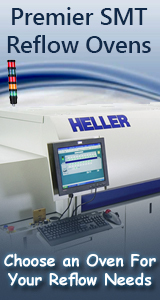Printed Circuit Board Assembly & PCB Design Forum
SMT electronics assembly manufacturing forum.
- SMTnet
- »
- Electronics Forum
- »
- SMT LEDS SOLDERING
SMT LEDS SOLDERING
Views: 4196
![]() Hi All,
we poduce diferent kind of Keyboards, and use a l...
- Sep 09, 2008
by
iv40
Hi All,
we poduce diferent kind of Keyboards, and use a l...
- Sep 09, 2008
by
iv40
![]()
![]()
![]() We consider "IR-reflow soldering profile" to be the supplier...
- Sep 09, 2008
by
davef
We consider "IR-reflow soldering profile" to be the supplier...
- Sep 09, 2008
by
davef
![]()
![]()
![]() 10x , davef,
about LEDs - the problem is , that about 1% of...
- Sep 11, 2008
by
iv40
10x , davef,
about LEDs - the problem is , that about 1% of...
- Sep 11, 2008
by
iv40
![]()
![]()
![]() How are they being stored and handled?
It might be an MSD i...
- Sep 11, 2008
by
Stephen
How are they being stored and handled?
It might be an MSD i...
- Sep 11, 2008
by
Stephen
![]()
![]()
![]() Questions are:
* Why aren't the defective LED blinking?
* ...
- Sep 12, 2008
by
davef
Questions are:
* Why aren't the defective LED blinking?
* ...
- Sep 12, 2008
by
davef
![]()
![]()
![]() Hi,
Why aren't the defective LED blinking?
* Do the defe...
- Sep 13, 2008
by
iv40
Hi,
Why aren't the defective LED blinking?
* Do the defe...
- Sep 13, 2008
by
iv40
![]()
![]()
![]() Tell us more about your ESD gloves.
* How are the grounded?...
- Sep 13, 2008
by
davef
Tell us more about your ESD gloves.
* How are the grounded?...
- Sep 13, 2008
by
davef
![]()
![]()
![]() We've found that storage of other LEDs from this manufacture...
- Sep 15, 2008
by
Bman
We've found that storage of other LEDs from this manufacture...
- Sep 15, 2008
by
Bman
![]()
![]()
![]() We have seen this same defect. Led's not blinking during tes...
- Sep 17, 2008
by
Bachman
We have seen this same defect. Led's not blinking during tes...
- Sep 17, 2008
by
Bachman
![]()
![]()
![]()
![]() Have seen similar problem before with regards the MSD being ...
- Sep 29, 2008
by
Ikon
Have seen similar problem before with regards the MSD being ...
- Sep 29, 2008
by
Ikon
![]()
- SMTnet
- »
- Electronics Forum
- »
- SMT LEDS SOLDERING





.gif)


